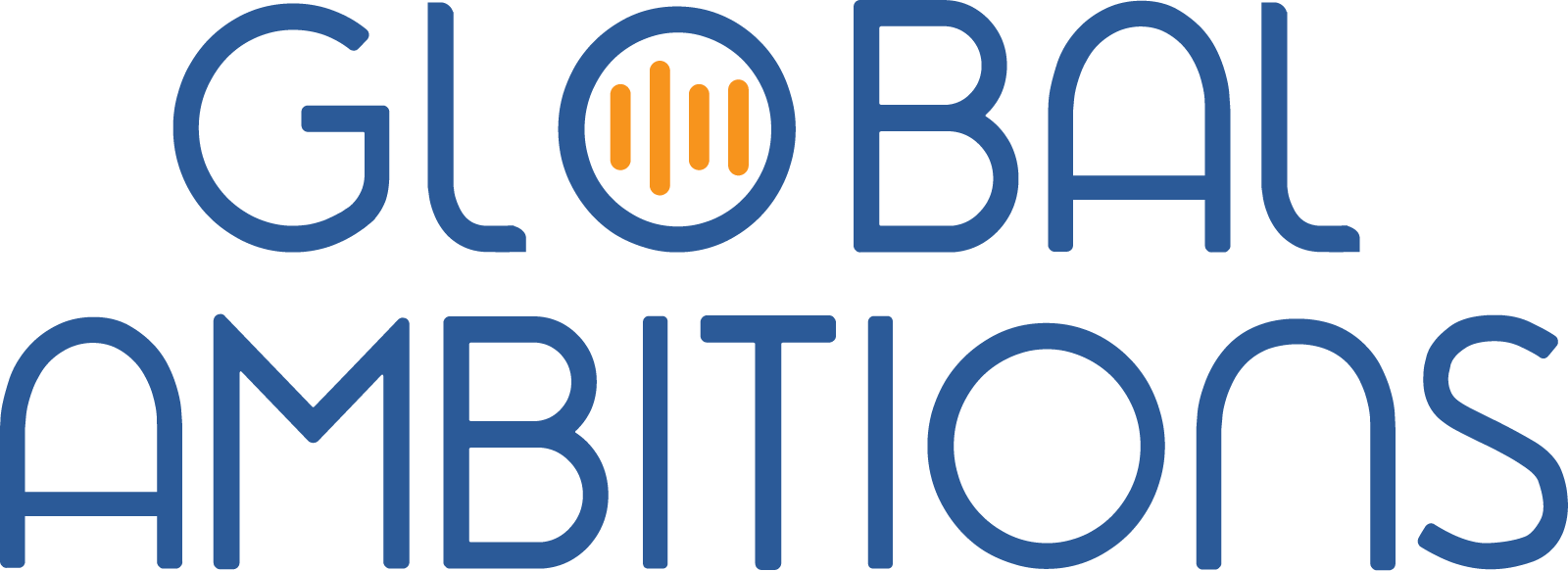With Teresa Marshall, VP of Globalization & Localization at Salesforce
Below is a full transcript of this episode
Antoine Rey 0:17
I’m Antoine Rey, and I will be your host today for this Global Ambitions episode. My guest today is Teresa Marshall, who is the VP of Globalization at Salesforce, and today the topic that we’ll be discussing is how do you avoid becoming a translation ticketing service, and gain a seat at the table instead. Theresa, welcome to the program.
Teresa Marshall 0:38
Thank you, thank you so much for having me. This is quite exciting.
Antoine Rey 0:41
Do you want to tell us maybe a little bit about what you do at Salesforce so that our listeners understand the context?
Teresa Marshall 0:47
Sure, sure. So like you said, I’m VP of Globalization and Localization, which means my teams are responsible for the majority of product localization and all the content that goes with that, across tech and products across R&D for Salesforce. I don’t own marketing. That’s basically what it comes down to.
Antoine Rey 1:07
So we mentioned in the topic today, how do you avoid becoming a translation ticketing service? Can you explain what ticketing service means in this case, in our own understanding?
Teresa Marshall 1:19
It’s sort of a different way of saying you’re the team that gets stuff thrown to them just sort of over the wall. No context no influence, no real say in when and how and where and you’re basically just an internal translation service provider, at which point I think you don’t add a lot of value. So, rather than being sort of just this pass-through of work to… hopefully, a strong partner but you want to be a real partner internally as well, so you can influence what’s coming down, and how the product is built and designed.
Antoine Rey 1:52
I think there was someone called Donato Giuliano from Hubspot the other day that said how do you become the queen and not Cinderella.
Teresa Marshall 1:59
I like that.
Antoine Rey 2:04
And so, what do you need to do to avoid becoming that? Because you have to build that in the first place. Somehow that ticketing service needs to be able to service the various groups but you don’t want to be pinned as just that I guess.
Teresa Marshall 2:19
Yeah, exactly. You don’t want to sort of be pushed into a particular corner and then not find a way out of it. I think there are some really sort of easy things you can do that seem sort of just soft skill type stuff and then there are other things you obviously have to do in the background.
Teresa Marshall 2:33
So for example, I rarely talk about our translators in general, I always talk about partners. I rarely talk about translation. We’re trying to talk about localization as a whole. Even though everybody understands that a big part of what we do is that that translation right so I sometimes go in and don’t even mention localization until halfway through the conversation. It’s all about market fit and features. And so you’re moving away from what everybody knows, which is that translation piece in which everybody has sort of this perception of like yeah you hand it to a translator and it comes back and it’ll be fine. And you sort of focus on everything around it. The upstream the, you know, business decision in terms of what language, what market, where, and how.
Antoine Rey 3:21
And when you say you’re having those conversations, who you’re talking about? There’s a big kind of a set of people that you have to have this conversation with?
Teresa Marshall 3:29
So it started to me really by having those conversations with individual product managers or individual engineers. And even in those conversations, I didn’t talk about translation because it’s one piece of the bigger process right so we all know it takes much more than one translation of a couple of strings to make a product and make it function and look and feel well. And for another market. So it really started early on in those conversations and whoever was my counterpart at the time right and then you try to push it up. You try to push it up, you try to push it further up into the process. And the more I had exposure to other functions, the more trying to sort of expand that as well.
Antoine Rey 4:12
Do you try to get an opportunity then beyond doing one to ones with those people to present to others… to groups of people to create like, I don’t know, some sort of a focus group that will probably educate or evangelize, what it is exactly that you guys are doing?
Teresa Marshall 4:27
Yeah, so nowadays we try to go into, you know, town halls into all the hand calls, we have early training as part of the onboarding of every new person that starts working in our org. And so we try to get the conversation as far upstream as we can but we also try to get the work as far upstream as we can. So it’s both in our operational point of view, we’re like okay, we don’t want to wait until everything is done. To be honest, we’re never gonna… in an agile environment we’re never going to have one localization person in each scrum team but we need to move that conversation, that touchpoint further. And so it’s everything from, like I said, from onboarding, down to the very sort of nitty-gritty conversations on a scrum team level. But yes, we go into town halls. We go try to find a way to highlight what we need, whether it’s from our content experience people, from our user experience people, from engineering, from product management. So we’re trying to spread our message there quite broadly.
Antoine Rey 5:28
Yeah, that’s interesting because we see a lot of younger newer companies and the localization managers, they try to follow that localization maturity model, and they come in and they put in place a TMS, they put in place a TM, they put in place some metrics around localization quality and time to market, and boom. They tell you that’s it we’re mature now. We’re level four, right. What do you say to people like that, then?
Teresa Marshall 5:55
Yeah, it’s interesting, so I had a conversation just last week about how do I get exactly that. How do I get away from sort of being on the receiving end. The question is never, like, how much do you put through your team and what’s your leverage. The question is what is the next market you want to be in, and why.
Teresa Marshall 6:12
So I try to think of internal and external metrics and KPI. What is important for me to know, right. If… of course, it’s important for me to know how much leverage we have or how much leverage lost we have if we do something like from one system to the other. And throughput is exceptionally important if you have internal linguists, which we don’t. We rely on a vendor to do all of that for us. But I don’t know that my manager would be interested or really truly have any input in terms of business understanding of that metric, right?
Teresa Marshall 6:45
So internally speaking in particular, if I go up my management chain, it doesn’t matter whether we pay 15 cents or 20 cents. That’s not what’s driving that. So it’s much more about, you know what is the, I don’t know… what are the user numbers? What is the financials that come in through that market? And so I think you always have to… and I had to learn this the hard way too right, so you always have to think about it in business terms rather than in translation.
Antoine Rey 7:13
So because I guess you need those metrics, the translation terms metrics, you know, to justify how many people you have in your team and what kind of budget you’re going to be having. But if we go into details a little bit, what kind of metrics do you need to report to that sphere of influence of those managers to elevate yourself and gain that seat at the table?
Teresa Marshall 7:35
So, I actually don’t even mention those metrics, because, to me, they are internal facing. External facing is really how much money for the company have you contributed to. Which is a really hard, tricky question to answer because that really depends on how your company reports revenue. Or whatever they report. How many users you have, whether you’re a consumer-facing product, or whether you’re a b2b kind of product whether you enterprise versus a startup. So it’s really difficult to say here’s the one metric. But you have to look at what is the market like and if you’re just starting out you have to see whether you can get numbers about the total addressable market.
Teresa Marshall 8:17
For example, let’s say you’re selling vacuum cleaners. Somebody in your company has to know how many vacuum cleaners. You could potentially sell in Germany or in Ireland or Italy, or wherever you are, right? And so you need to get that data and then learn how to use it to your advantage. Maybe out of curiosity, it’s sort of my paygrade so to say, he’s interested in how much money we use for the actual translation costs but ultimately it’s about where do we contribute, whether that’s in terms of revenue or whether that’s in terms of case deflection in terms of support. That’s really what they’re being held accountable for and so the trick is to align yourself with that.
Antoine Rey 9:00
There’s no one magic ROI for localization that everybody’s looking for it really depends on every company and, and really the way you’re looking at the markets.
Teresa Marshall 9:11
Well, I think there’s a couple of guidelines that people will look at, and then they will adjust it to themselves. So if you’re a consumer-facing product, you need to look at monthly active users and how do you grow that. If you’re an enterprise you’re looking at, you know, what share particular markets contribute to your revenue and then you try to grow that. But it’s really hard to say hey we localize our product in country X and therefore the revenue from that country X is directly related to localization. I’m sure localization played some part in it, but there are all these other contributors like what kind of salespeople do you have, what kind of sales material do you share, what marketing do you do, do you have direct marketing, do you have sort of like broad advertising. It’s like it really depends on how that all sort of comes together, you can’t just say we’re great. We’re doing great in Turkey and that’s because we localized everything for Turkey. It would be nice if it was that simple.
Antoine Rey 10:09
But would you still report yourself some of those numbers that we talked about the total addressable market, the contribution of the monthly active users, for instance, and the all-hands meeting whenever you have an opportunity?
Teresa Marshall 10:23
Yeah, because if you can actually get your hands on that data and sort of slice it and dice it in a way that shows what role localization plays it’s definitely important right? So we do go, and while we don’t say hey we pay X cent per word, or we process this many words or something like that we play with it right? So, rather than saying we do, I don’t know, whatever, 2000 words a day, we talk about how many volumes of Harry Potter we translated in a year because that’s what somebody can understand who has no clue about what, you know, how many words are on a regular page right? So we try to have some sort of dimension just to show the volume that we do, but we don’t talk about that in terms of price, or money, but we will definitely see how we can use monthly active users and TAM and all these kinds of things to our advantage to say hey, look at it. Here’s the company but here’s everything that is non-English speaking, and then it’s hard to sort of ignore that because typically the number is, if it’s not huge, it’s growing, and you can use that to your advantage.
Antoine Rey 11:27
And I think that’s quite important that listeners understand that you can use those numbers to your advantage. It doesn’t mean you’re claiming that you’re the sole contributor or responsible for those numbers.
Teresa Marshall 11:38
Exactly, exactly. I think it’s a lot about contribution to the overall goal of the company right? I think that’s one way of looking at it’s like if we were fighting about prioritization of market and budget and languages and stuff like that it’s all about aligning to your overall roadmap, and sort of pointing out where we contribute to that.
Antoine Rey 11:59
So how long does it take to become Cinderella? Oh no, the other way around. To become the queen?
Teresa Marshall 12:06
Oh, if only you had like a magic way of seeing that. I think I always joke that localization is definitely a long game, right? And so it really depends on your company, to when and where they hit that magic number where they say okay now we really need to focus on markets outside of the US or outside of the English speaking markets and so that’s really up to you. You need to keep an eye on that and then you become a broken record and that’s what it takes. It’s less about time. It’s more about can you consistently tell your story. And then when the time is right, in particular, if you have this conversation about aligning your roadmap, it’ll happen right.
Teresa Marshall 12:43
But you know sometimes that happened really quickly because somebody’s upstairs closing really quickly or you have a product that is exceptionally successful outside of the US or the English-speaking market right? If it’s a small app there’s a very different story than if it’s a gigantic enterprise right? But I think the trick is to be very consistent in your approach to that. To not cave in to all, then you become sort of the internal localization services part. Once you are in sort of this ticketing system, it’s hard to change perception again so you want to build the perception as an integrated part of your development process. I play a role in the development cycle, and not just afterward.
Antoine Rey 13:23
And that’s critical. Yeah, and I’ve seen, like, a lot of people when they try to build that perception, they start, obviously with the ticketing service because that needs to be part of the solution as well, but really it’s a communication that to the rest of the organization that’s going to make that difference on how they proceed.
Teresa Marshall 13:42
Yeah, and I think it’s like, even if you have the most glorious TMS in place that pulls everything magically from everywhere. That’s fantastic. Right, that’s sort of almost, here’s my whole sales solution and all you have to do is hook into that and we’ll be fine. And you can sell that without losing track of having the final conversations about what that market should look like, what the future should look like. That automation is just one way of freeing you up to have some more value-added conversations that you need to have.
Antoine Rey 14:12
Teresa, thanks very much again for joining our show. I know we will have plenty of downloads from our listeners for this episode, and we look forward to speaking with you again soon.

Teresa Marshall
VP of Globalization & Localization at Salesforce




